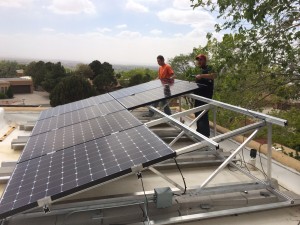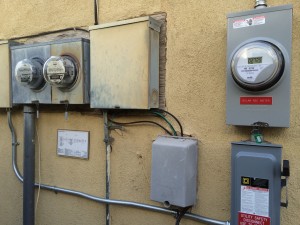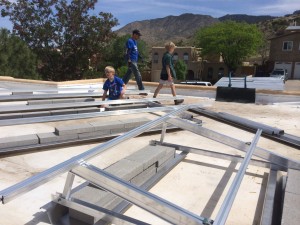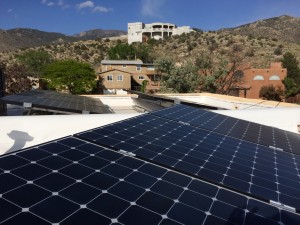Once I overcame the shock of getting a $350+ electric bill and then had done enough research to be convinced that putting solar panels in my home not only was a good idea to help preserve the environment, but also to save money and raise its property value, the next step was installation.
In the case of my own home, since it is all-electric and has refrigerated air, we were going to require a lot of panels. We  received an energy audit and had numerous evaluations by engineers, and it was determined we would need 30 photovoltaic solar panels or a 9.81 kWh (kilowatt hour) solar system to offset our energy use through the course of the year.
received an energy audit and had numerous evaluations by engineers, and it was determined we would need 30 photovoltaic solar panels or a 9.81 kWh (kilowatt hour) solar system to offset our energy use through the course of the year.
Depending on whether you live in the city or in the country sometimes it is better to have the panels connected to a battery apart from the electric company for storing energy to use at night or during severe cloud cover. This is what they call “living off the grid.” The other option is to have the solar system feed right into the electric company’s meter. At nighttime no solar energy is being produced and the meter moves forward as usual, measuring usage. However, during the day when solar energy is produced, and if consumption is less than production, the METER ACTUALLY GOES IN REVERSE! When that happens that means that energy is being sold to the utility company (or “net metering”).
 There is nothing more satisfying than watching your electric meter move in reverse. Living here in the Sunbelt where according to the Current Results Website we average 278 sunny days in Albuquerque, it’s no surprise to see a meter connected to a solar system spinning backwards. And because I entered into an eight-year contract with my electric company, their buy-back rate is guaranteed during that period. Of course, there is speculation the rate will go down, but no one knows for sure.
There is nothing more satisfying than watching your electric meter move in reverse. Living here in the Sunbelt where according to the Current Results Website we average 278 sunny days in Albuquerque, it’s no surprise to see a meter connected to a solar system spinning backwards. And because I entered into an eight-year contract with my electric company, their buy-back rate is guaranteed during that period. Of course, there is speculation the rate will go down, but no one knows for sure.
 The installation itself only took five days. We have a flat roof so we decided to get a “ballast system.” This is where the frames that sustain the panels are held in place by cinder blocks (rather than bolted in) and are designed to withstand winds up to 120 miles per hour. The result is a gorgeous design with 30 photovoltaic panels feeding into two inverters that convert solar energy into alternative current (AC). This converted energy leads to the Renewable Energy Credit (REC) Meter that, of course ultimately ties into the electric company’s meter.
The installation itself only took five days. We have a flat roof so we decided to get a “ballast system.” This is where the frames that sustain the panels are held in place by cinder blocks (rather than bolted in) and are designed to withstand winds up to 120 miles per hour. The result is a gorgeous design with 30 photovoltaic panels feeding into two inverters that convert solar energy into alternative current (AC). This converted energy leads to the Renewable Energy Credit (REC) Meter that, of course ultimately ties into the electric company’s meter.

The moment of truth came one full month after the installation of our solar system…receiving the electric bill. I opened the envelope and, low-and-behold my utility company had cut me a check for $60.00!!!
I am so entirely satisfied with my solar system that I’d like to invite anyone who’s interested to see it in action. I am organizing a “Solar Party” at my home in Albuquerque to explain how the system works and serve appetizers on:
July 26, 2014 from 3:00 – 5:00PM
RSVP Sutter Sugar (505) 850-9977 or Sutter@TheSugarTeam.com to learn to live just a little bit GREENER.